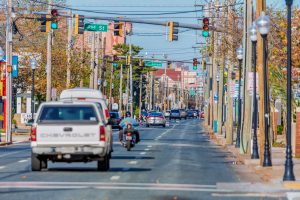
OCEAN CITY – The resort has reached a critical crossroads in the future of Baltimore Avenue as a decision is needed on the roadway’s redevelopment.
In recent years, a major renovation of the streetscape along the Baltimore Avenue corridor from North Division Street to 15th Street including undergrounding the utilities and widening the sidewalks, for example, has been on the town’s radar, but the issue is complicated. The state owns the actual roadway and the State Highway Administration (SHA) has been chomping at the bit to repave Baltimore Avenue and bring its sidewalks into Americans with Disabilities Act (ADA) compliance.
SHA was planning to repave and expand the sidewalks along that section of Baltimore Avenue at least two years ago. However, Ocean City at the time was considering a complete renovation of the Baltimore Avenue corridor, largely a gateway to the resort and a first impression of the town for many.
The major renovation of the corridor, marked by countless unsightly utility poles and overhead wires, has been a top priority for town officials, who asked SHA to put its repaving project on the backburner until a plan could be developed and a way to pay for the project was developed. During a presentation of the draft fiscal year 2022 capital improvement plan this week, City Engineer Terry McGean explained different options for renovating that section of Baltimore Avenue with a wide range of price tags. McGean explained the time has come to make a decision.
“There are two options, really,” he said. “One option in the CIP is around $500,000 to widen the sidewalks on the east side of Baltimore Avenue. The second option and much more expensive project is to underground the utilities and shift the street slightly to the east to allow for the widening of the sidewalks on both sides. The small-scale project is half-a-million and the larger-scale project would likely cost $15 million to $20 million.”
The alternatives range from simply doing nothing and allowing SHA to come through and repave the corridor and make the requisite ADA improvements to a complete remodel of the corridor including undergrounding the utilities, thereby eliminating the often-unsightly poles and overhead power lines. The latter has been done successfully in other areas of town, but there is a significant cost associated with it.
Complicating the issue further is the existence of a long forgotten and underutilized right-of-way along the Baltimore Avenue corridor. Baltimore Avenue is unique in a variety of ways. For example, the original deeds show the right-of-way as 75 feet wide, but the current roadway only utilizes about 45 feet from curb to curb.
A review of the ancient deeds for Baltimore Avenue reveal a no man’s land of about 32 feet in some areas that could ultimately be deeded back to the property owners along the corridor or used to widen the roadway and its sidewalks. Over the decades, however, private property has steadily encroached on the original right-of-way platted over a century ago. For example, in some cases, private businesses along the corridor have signs in the old right-of-way, while others have parking areas. In some cases, the long-forgotten right-of-way is just covered with grass or landscaping and isn’t necessarily utilized by the private sector.
“Baltimore Avenue is a little strange,” said McGean. “The state’s portion is essentially the roadway and we own the portion to the front edge of the sidewalks. There is also that no man’s land of public right-of-way. That would be the last stretch of Baltimore Avenue that needed to be undergrounded.”
Public Works Director Hal Adkins, while not entirely advocating for the expensive streetscape renovation for Baltimore Avenue, said undergrounding the utilities would greatly improve the aesthetics of the corridor. He pointed to other areas throughout town where the utilities have been undergrounded in recent years, including St. Louis Avenue most recently.
“Having done undergrounding projects since the 1990s, should you desire to pursue this, it drastically changes the character of the corridor,” he said. “It also improves fire safety along the corridor without all of those poles and wires overhead.”
In a nutshell, the town is faced with the decision to have SHA come in and make its improvements to the state’s portion of Baltimore Avenue while spending around $500,000 to enhance the sidewalks, or pull the trigger on the larger complete renovation that could cost as much as $20 million. In either case, the section of no man’s land right-of-way could be deeded back to the property owners along the corridor. Councilman John Gehrig said the decision was a tough one, but the time to make it was soon coming.
“This is kind of do or die project,” he said. “Once State Highway comes in and paves it and does the sidewalks, this thing could get pushed back 20 to 30 years.”
McGean said Gehrig’s sentiments sum up the situation.
“That’s pretty much true,” he said. “Otherwise, we would be ripping out all of those new sidewalks and paving. It really is reaching a critical decision time.”

